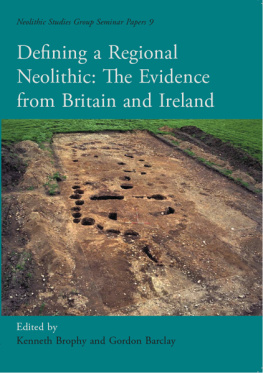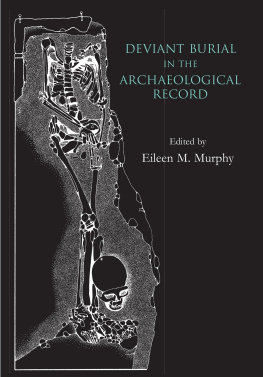Published by
Oxbow Books, Oxford, UK
Oxbow Books and the individual authors, 2009
ISBN 978 1 84217 333 6
EPUB ISBN: 978 1 78297 292 1
PRC ISBN: 978 1 78297 293 8
A CIP record for this book is available from The British Library
This book is available direct from
Oxbow Books, Oxford, UK
(Phone: 01865-241249; Fax: 01865-794449)
and
The David Brown Book Company
PO Box 511, Oakville, CT06779
(Phone: 860-945-9329; Fax: 860-945-9468)
or
from our website
www.oxbowbooks.com
Cover: Neolithic timber hall at Claish, Stirlingshire, during excavation in 2001
( Crown Copyright RCAHMS)
Printed in Great Britain by
The Information Press
Eynsham, Oxfordshire
Foreword
This volume of papers is the ninth set of proceedings from a meeting of the Neolithic Studies Group to be published. As with previous volumes, it includes reflective versions of papers given at a meeting of the group, as well as additional material.
The Neolithic Studies Group is a loose-knit collectivity of archaeologists, mainly from the British Isles and the Atlantic seaboard countries of Europe, with an interest in the Neolithic period. It was formed in the Spring of 1984, the first meeting being held in Cheltenham, Gloucestershire, UK. Since then, the Group has generally met twice a year: Spring and Autumn. The Autumn meetings are held in London and address a specific topical theme. Spring meetings are held outside London to examine at first hand the Neolithic remains of a defined area and consider recent research relevant to the region. Spring field meetings have included: western Ireland, south-east Scotland, eastern Scotland, north Wales, North Yorkshire and Humberside, Northumberland, Wessex, the Channel Islands, Sussex, Cambridge and Grimes Graves, Normandy, Isle of Mann, the Peak District, Caithness, Orkney and Brittany.
All the meetings depend for their success upon the efforts and enthusiasm of local organisers. The occasion of publishing this volume provides an appropriate opportunity to thank all those who have helped organise the Groups meetings in recent years.
Membership of the Neolithic Studies Group is open to anyone active in studying any aspect of the Neolithic period in Europe. The present membership list, which stands at around 250 individuals, includes: academic staff, researchers and students from universities and colleges in several European countries; museum curators and museum-based research and field staff; and field archaeologists from national and local government organisations and from archaeological trusts and units. There is no application procedure or subscription fee to join the Group; members are simply those currently on the mailing list. Anyone can ask to be added to the mailing list at any time, the only rule of the Group is that names are deleted from the list if the individual concerned misses four meetings in a row (ie. two years) and has not contacted the Group Co-ordinators asking to be kept on the list during that time.
For further information about the history of the Group, details of forthcoming events and publications, and details of how to join our mailing list, visit the Groups web site:
www.neolithic.org.uk
As already mentioned, the Group relies on its members to organise meetings so that this responsibility is shared round. There are two Co-ordinators who look after the mailing list and finances, and who juggle offers to arrange meetings so that there is a fair spread of venues and themes.
We hope that you will find this volume of papers published by the Neolithic Studies Group useful, and we look forward to seeing you at one of our future meetings.
Timothy Darvill and Kenneth Brophy
(Neolithic Studies Group Co-ordinators)
Contents
by the Co-ordinators of the Neolithic Studies Group |
Gordon Barclay
|
Kenneth Brophy
|
Fiona Roe
|
Roy Loveday
|
Vicki Cummings
|
Aaron Watson and Richard Bradley
|
Tom Clare
|
Patrick Clay
|
Gabriel Cooney
|
Carleton Jones
|
Preface and Acknowledgements
This volume of papers represents the rather belated proceedings of the meeting of the Neolithic Studies Group held in Burlington House, Society of Antiquaries of London, on 12 November 2001 (most of the papers were submitted in near final form in 2002). The topic of that particular meeting of the group, Regional diversity in the Neolithic of Britain and Ireland, drew a wide range of papers, the majority of which are represented in this volume; an additional paper () was offered and accepted after the meeting. The session itself was organised by the editors of this volume. Although the day meeting itself was not organised along any thematic lines, a loose tripartite structure has been applied: Defining regional Neolithics; Material culture; and Regional and local studies.
The day meeting itself was driven by a series of four questions, and by way of introduction to the volume, Barclay has expanded on these, and his introductory comments made on the day, to form a comprehensive introduction to this volume (), analysing that most familiar of tools for the display of archaeological data, the distribution map. These two papers set out some of the parameters for the volume, essentially Defining regional Neolithics for the reader.
The two papers that follow address the role Material culture plays in both defining and characterising regional trends, covering a diverse range of forms of material culture, starting with an analysis of querns by Roe () considers a wider range of objects from the Neolithic of Yorkshire and beyond. Artefacts in much earlier archaeological studies were used, through typology and culture-history, to establish misguided models of Neolithic traditions in the British Isles, but these three studies aim to re-think artefacts within a different theoretical framework.
The third section of the book considers a series of Regional and local studies, the definition of both regional and local being ambiguous at best here, suggesting, as do the contributions, that a number of cross-cutting scales of identity were in operation in the Neolithic. Papers focus largely on the so-called Irish Sea Zone: Cummings () in a detailed analysis of a large body of Neolithic data from the East Midlands.
One of the defining characteristics of the day meeting, and this volume, was that contributors steered clear of the usual suspects Wessex and Orkney. This is not to say that the volume contains a number of rival regions, nor indeed that individual contributors are describing clear-cut Neolithic regions. However it does suggest, along with notable historiographies of the Neolithic (e.g. ), that there is something in the air that demands a closer inspection of the evidence elsewhere. Not only that, but interpretations should be applied that have an element of local contingency rather than drawing on universal theories applied in the old core areas in the south and far north of the Britain. The papers here represent for us an embodiment of the sentiment so admirably expressed over a decade ago by Harding (1991), who described Wessex as unique, not typical.
The editors would like to thank the Society of Antiquaries of London, especially Dai Morgan Evans, for organising the use of the Societys rooms in Burlington House, and for coping with a full house on the day. Our thanks also to the contributors on that day back in 2001, and for all those who offered a paper for this volume: your patience has been noted and appreciated.
Next page












